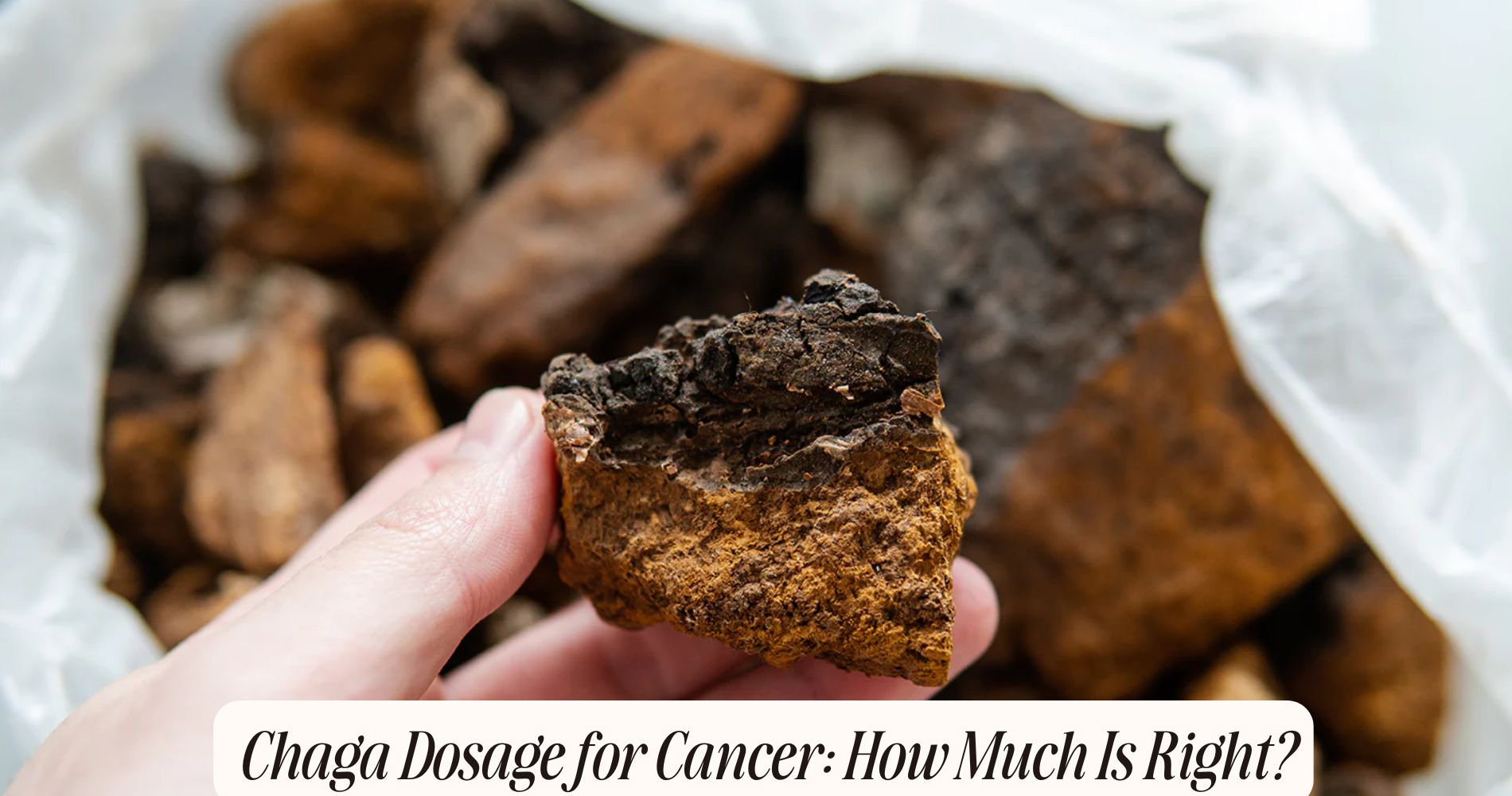
How Much Chaga Is Too Much? Find Out Here
How much chaga is too much? Generally, consuming more than 3 grams of dried powder or 10 grams of fresh chaga daily may lead to side effects like gastrointestinal discomfort, hypoglycemia, and fatigue. Individual factors like age and health status can impact your tolerance, so it's best to start with smaller doses and monitor your body's response. Those with liver conditions or on certain medications should be cautious. For personalized advice and safe use, consult a healthcare professional. There's more to explore about chaga's effects and how to use it safely!
What Is Chaga?
Chaga, a type of fungus scientifically known as Inonotus obliquus, primarily grows on birch trees in cold climates, and it's becoming increasingly popular for its potential health benefits.
This fungus, often referred to as a "mushroom" in colloquial terms, isn't a true mushroom but rather a sclerotium, a hardened mass of mycelium. The Chaga species thrives in habitats with cold temperatures, especially in northern regions like Siberia, Canada, and parts of Northern Europe.
Historically, Chaga has been utilized in traditional medicine, particularly in Russia and other areas where it naturally occurs. Ancient cultures recognized its value, using it to boost immunity and combat various ailments.

As you explore Chaga harvesting, it's essential to understand responsible practices. Harvesting Chaga involves carefully cutting the sclerotium from the birch tree, ensuring that the tree remains healthy and can continue to support the fungus.
Overharvesting can lead to ecological imbalances, so sustainable methods are paramount. By grasping Chaga's history and the specifics of its habitats, you gain insight into its significance and the importance of mindful harvesting practices.
Health Benefits of Chaga
Chaga is known for its potential health benefits, particularly in supporting your immune system.
Research indicates that its antioxidant properties can combat oxidative stress, while its anti-inflammatory effects may help reduce chronic inflammation.
Understanding these benefits can inform your decisions about incorporating Chaga into your wellness routine.
Immune System Support
When it comes to boosting your immune system, incorporating Chaga into your wellness routine can be a game changer. This medicinal mushroom has been studied for its ability to support immune response effectively. Research indicates that the polysaccharides and beta-glucans found in Chaga play a significant role in modulating your immune system, enhancing its ability to fight off pathogens.
Chaga benefits extend beyond mere enhancement; it also helps regulate immune cell activity. Certain studies have shown that Chaga can stimulate the production of immune cells, such as macrophages and natural killer cells. These cells are essential for your body's defense mechanisms, as they identify and eliminate harmful invaders.
Moreover, the anti-inflammatory properties of Chaga contribute to a balanced immune response, preventing overactivity that can lead to autoimmune issues. By including Chaga in your daily regimen, you're not just boosting your immunity; you're also fostering a healthy, well-regulated immune system.
However, as you explore these benefits, remember to monitor your intake, as too much Chaga can lead to adverse effects. Balance is key to maximizing its immune-supporting properties.
Antioxidant Properties
Numerous studies highlight the impressive antioxidant properties of Chaga, making it a valuable addition to your health regimen. Research shows that Chaga contains high levels of polyphenols and other compounds that combat oxidative stress, which can lead to cellular damage and chronic diseases.
By incorporating Chaga into your routine, you can enhance your body's ability to neutralize harmful free radicals, effectively reducing the risk of oxidative damage.
The antioxidant capacity of Chaga is often attributed to its unique composition, including compounds like betulinic acid and superoxide dismutase. These elements work synergistically to improve chaga bioavailability, ensuring that your body absorbs and utilizes these beneficial compounds efficiently.

Furthermore, studies indicate that Chaga may inhibit chaga oxidation, thereby preserving its antioxidant potency. This means that not only is Chaga effective at fighting oxidative stress, but it also maintains its efficacy over time.
Anti-Inflammatory Effects
The impressive antioxidant properties of Chaga often correlate with its anti-inflammatory effects, making it an appealing option for those looking to reduce inflammation in the body. Research suggests that Chaga benefits individuals suffering from chronic inflammatory conditions, such as arthritis and cardiovascular diseases.
Its bioactive compounds, particularly betulinic acid and polysaccharides, have been shown to inhibit inflammatory pathways, thereby alleviating symptoms associated with these conditions.
When you incorporate Chaga into your diet, you're tapping into a natural remedy supported by scientific evidence. Studies indicate that extracts from Chaga can lower levels of pro-inflammatory cytokines, promoting a healthier inflammatory response.
This means that by using Chaga sources like teas, powders, or capsules, you might experience reduced pain and improved mobility if you're dealing with inflammation.
However, it's important to understand that while Chaga offers potential anti-inflammatory benefits, it shouldn't replace conventional treatments without consulting a healthcare professional.
Balancing Chaga with other lifestyle changes, such as a nutritious diet and regular exercise, can further enhance its effectiveness in managing inflammation.
Recommended Dosage Guidelines
When considering chaga's potential benefits, it's vital to follow recommended dosage guidelines to guarantee safety.
Daily intake recommendations typically vary based on individual health conditions and goals, so understanding these nuances is essential.
Additionally, being aware of potential risks can help you make informed decisions about incorporating chaga into your routine.
Daily Intake Recommendations
Determining the right amount of chaga to consume daily can be crucial for reaping its health benefits without overdoing it. Research suggests that a typical daily dosage ranges from 1 to 3 grams of dried chaga powder or 5 to 10 grams of fresh chaga.

It's essential to source your chaga responsibly, as sustainable chaga sourcing not only protects the environment but also guarantees you're getting high-quality fungi.
When considering your intake, remember that individual factors such as age, health status, and specific wellness goals play a significant role in your ideal dosage. It's wise to start at the lower end of the recommended range and gradually increase your intake while monitoring your body's response.
Additionally, you should verify that the chaga you're consuming is harvested sustainably, as irresponsible harvesting can lead to depletion of wild chaga populations.
This not only affects the ecosystem but also compromises the availability of this valuable resource for future use. By adhering to these dosage guidelines while prioritizing chaga sustainability, you can enjoy the potential benefits of chaga without risking adverse effects or contributing to environmental harm.
Safety Considerations and Risks
Understanding the potential safety considerations and risks associated with chaga consumption is essential for anyone looking to incorporate it into their wellness routine. While chaga is generally recognized for its health benefits, it's imperative to source it responsibly. Poor chaga sourcing can lead to contamination, which might expose you to harmful substances.
Always choose products from reputable suppliers who prioritize chaga sustainability and ethical harvesting practices.
In terms of dosage, sticking to the recommended guidelines is critical. Excessive consumption may lead to digestive issues or interfere with blood sugar levels. If you're on medication, particularly anticoagulants or antidiabetics, consult your healthcare provider before adding chaga to your regimen.
Pregnant or breastfeeding individuals should also exercise caution, as safety data in these groups is limited.
Additionally, chaga contains oxalates, which can contribute to kidney stones in susceptible individuals. As a result, moderation is key.
Regularly evaluate your body's response to chaga and adjust your intake accordingly. By being mindful of these safety considerations, you can enjoy the benefits of chaga while minimizing potential risks.
Signs of Overconsumption
Consuming chaga in moderation is vital, as overindulgence can lead to several adverse effects. When you exceed the recommended dosage, you may start experiencing overconsumption symptoms that can disrupt your well-being. One of the most common signs of excessive intake is gastrointestinal discomfort, including nausea, bloating, or diarrhea. These symptoms arise because your body struggles to process the high concentration of compounds found in chaga.
Additionally, you might notice changes in your blood sugar levels. Chaga is known for its ability to lower glucose, and excessive intake could lead to hypoglycemia, characterized by dizziness, weakness, and confusion. If you're on medication for diabetes, it's vital to monitor your blood sugar closely.
Another sign to watch for is fatigue. While chaga is often consumed for its energy-boosting properties, too much can have the opposite effect, leaving you feeling lethargic.
Potential Side Effects
When it comes to chaga, being aware of the potential side effects is essential for maintaining your health. While chaga is praised for its health benefits, it's vital to understand the risks associated with its consumption. Research indicates that excessive intake may lead to chaga toxicity effects, which can manifest as gastrointestinal discomfort, including nausea, diarrhea, or stomach cramps.
Additionally, long-term consumption of chaga might pose additional risks. Some studies suggest that prolonged use could potentially affect liver function, particularly in individuals with pre-existing liver conditions.

Moreover, chaga has anticoagulant properties, which means it may thin the blood; this could heighten the risk of bleeding, especially if consumed in large amounts over time.
It's also worth noting that chaga may contain high levels of oxalates, which can contribute to kidney stones in susceptible individuals.
As a result, if you're considering incorporating chaga into your routine, moderation is key. Always listen to your body and consult healthcare professionals if you experience any adverse effects.
Interactions With Medications
While being mindful of chaga's potential side effects, it's also important to contemplate how this mushroom might interact with medications you may be taking. Chaga interactions can greatly influence medication effects, leading to either enhanced or diminished efficacy.
For instance, chaga may affect blood sugar levels, which is vital if you're on diabetes medications. Combining these could lead to hypoglycemia or overly elevated blood sugar.
Moreover, chaga possesses anticoagulant properties, meaning it can thin your blood. If you're on blood thinners like warfarin, this could increase your risk of bleeding.
Additionally, chaga may influence liver enzymes responsible for metabolizing various drugs. This means it could alter how long medications stay in your system, potentially leading to toxic levels or reduced effectiveness.
Given these possibilities, it's important to consult with a healthcare professional before adding chaga to your regimen, especially if you're on multiple medications. They can help you navigate potential chaga interactions and make sure your treatment plan remains safe and effective.
Always prioritize your health by being informed about how natural supplements like chaga can impact your prescribed medications.
Factors Influencing Dosage
Determining the appropriate dosage of chaga involves several essential factors that can greatly influence its effectiveness and safety.
Initially, the method of chaga sourcing plays a significant role. High-quality chaga, harvested sustainably, tends to have a higher concentration of active compounds, which can affect the amount you should take. If you're using chaga sourced from reputable suppliers who prioritize sustainability, you may find that a smaller dosage is effective compared to lower-quality products.
Secondly, individual factors, such as your age, weight, and overall health, can also impact the ideal dosage. For instance, if you have underlying health conditions or are taking medications, your body may require a different amount to achieve the desired benefits without adverse effects.
Lastly, the form of chaga (powder, extract, or tea) can influence how much you should consume. Each form varies in concentration, so understanding these distinctions is vital.
Safe Consumption Practices
Understanding how to safely consume chaga is vital to maximizing its benefits and minimizing any potential risks. First and foremost, it's important to follow recommended practices regarding dosage. Most studies suggest starting with a low dose, typically 1 to 2 grams per day, then gradually increasing it as your body adjusts. This cautious approach helps you monitor for any adverse effects, allowing you to find your individual tolerance level.

Safe sourcing is another key aspect of consumption. Make sure you obtain chaga from reputable suppliers who prioritize quality and transparency. Contaminants from poorly sourced chaga, such as heavy metals or pesticides, can pose significant health risks. Look for products that undergo third-party testing to verify their purity and potency.
Additionally, consider your own health conditions or medications, as chaga can interact with certain treatments, particularly anticoagulants. Consulting with a healthcare provider before adding chaga to your regimen can provide tailored guidance based on your personal health profile.
How to Incorporate Chaga
Incorporating chaga into your routine requires understanding the recommended daily dosage and effective preparation methods.
Research suggests starting with a low dose and gradually increasing it to assess your body's response.
Additionally, knowing how to prepare chaga, whether as a tea or extract, can enhance its benefits and guarantee ideal consumption.
Daily Dosage Recommendations
As you explore the benefits of chaga, it's vital to evaluate the appropriate daily dosage to maximize its effects while minimizing potential risks. Research suggests that a daily intake of 1 to 3 grams of chaga, depending on the form you choose, can be effective. If you opt for chaga powder or capsules, start at the lower end and gradually increase as you monitor your body's response.
Keep in mind that chaga is available in various forms, including extracts, teas, and powders. Each form may have different concentrations of active compounds, influencing how much you should consume. For instance, chaga tea typically requires more raw material to achieve equivalent benefits compared to concentrated extracts.
Additionally, consider your chaga sources. Confirm you're obtaining your chaga from reputable suppliers to guarantee quality and potency. Poor-quality sources may contain contaminants or lower active ingredient levels, which can skew your dosage effectiveness.
Ultimately, listening to your body is significant. If you experience any adverse reactions, it may be wise to adjust your intake or consult a healthcare provider for personalized guidance.
Preparation Methods Explained
When it comes to enjoying the benefits of chaga, knowing how to prepare it properly is vital. Chaga can be incorporated into your routine using various brewing techniques and extraction methods. One popular method is brewing chaga tea. To do this, you'll want to use dried chaga chunks or powder. Steep the chaga in hot water (around 160°F to 185°F) for at least 30 minutes, allowing the beneficial compounds to dissolve into the water.
Another effective extraction method is creating a chaga tincture. This involves soaking chaga in alcohol for several weeks, which extracts the active constituents more efficiently. The tincture can then be taken in smaller doses, making it a potent option for those seeking concentrated benefits.
You can also consider adding chaga powder to smoothies, soups, or even baked goods. This method allows for easy integration into your diet while maximizing the potential health benefits.
Regardless of the method you choose, make sure that you're sourcing high-quality chaga to maximize its efficacy. By understanding these preparation methods, you'll be able to enjoy chaga's full range of health benefits while maintaining proper dosage.
Consulting With Healthcare Professionals
Steering through the complexities of health supplements, like chaga, often necessitates professional guidance. When considering incorporating chaga into your regimen, a chaga consultation with a healthcare professional is vital. They can help you assess your individual health status, potential interactions with medications, and the appropriate dosage tailored to your needs.
Healthcare advice is critical, especially since chaga contains bioactive compounds that can affect various bodily systems. For instance, its potential anti-inflammatory and immune-boosting properties mightn't be suitable for everyone, particularly those with autoimmune conditions.

Furthermore, excessive consumption can lead to adverse effects, including gastrointestinal issues or liver toxicity.
Engaging in a conversation with a healthcare provider guarantees you receive evidence-based recommendations. They can evaluate any pre-existing conditions or medications that could interact negatively with chaga, allowing you to make informed choices.
Remember, what works for one person may not work for you. Prioritizing your health through professional guidance can help you enjoy the benefits of chaga while minimizing risks.
Always consult a healthcare professional before making any significant changes to your supplement routine, assuring your approach is both safe and effective.
Frequently Asked Questions
Can Children Safely Consume Chaga?
You should consult a healthcare professional before giving chaga to children. While chaga benefits include immune support, appropriate chaga dosage for kids isn't well-studied, so it is crucial to prioritize their safety and wellbeing.
Is Chaga Safe for Pregnant or Breastfeeding Women?
While chaga offers potential benefits, its safety for pregnant or breastfeeding women isn't well-studied. You should consult a healthcare professional to weigh possible chaga side effects against the advantages before making any decisions.
How Long Can I Take Chaga Without a Break?
You should follow chaga dosage recommendations, typically taking breaks after several months. Long-term effects aren't fully understood, so monitoring your body's response is crucial while using chaga to ascertain it remains safe and effective.
Can Chaga Be Consumed in Different Forms?
You can consume chaga in various forms like teas, extracts, or powders. Each preparation offers different chaga dosages, so it's crucial to reflect on your needs and choose the form that best suits your lifestyle.
What Is the Best Time of Day to Take Chaga?
The best time to take chaga varies. For morning benefits, it boosts energy and immunity. In the evening, it may promote relaxation and better sleep. Consider your goals to decide when's best for you.
Conclusion
Incorporating chaga into your routine can offer various health benefits, but moderation is key. Staying within recommended dosage guidelines helps avoid potential side effects. Always pay attention to your body's signals and consult healthcare professionals if you're unsure about your intake. By understanding the factors that influence dosage and practicing safe consumption, you can enjoy chaga's advantages without overdoing it. Remember, balance is essential for maximizing benefits while minimizing risks.




